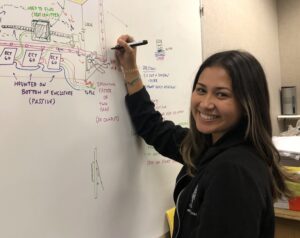
Abigail Macalintal was born and raised in Kailua on the island of Oahu. After graduating from Kamehameha Schools Kapalama in 2021, she attended the University of Hawaii at Manoa. Abigail is currently an upcoming junior, pursuing a Bachelor of Science degree in Mechanical Engineering. She is the President of the Society of Automotive Engineers at UH-Manoa and a member of the Native Hawaiian Science & Engineering Mentorship Program (NHSEMP) at UH Manoa. In her spare time, Abigail enjoys collecting shells, propagating plants, taking her dog Elijah on walks, and spending time with her family.
Home Island: Oahu
High School: Kamehameha School
Institution when accepted: University of Hawaii at Manoa
Designing, Prototyping, and Fabricating an Advanced Enclosure for the UH88 Wide-Field Imager Off-Axis Guider System
Project Site: UH Institute for Astronomy, Hilo, HI
Mentors: Luke McKay & Mark Chun
Project Abstract:
The University of Hawaii 2.2-meter Telescope, commonly referred to as the UH88, holds the distinction of being the first large telescope built on Mauna Kea in 1968. Since then, both imaging and spectroscopic instruments have been upgraded many times. Currently, we are working on designing and prototyping a permanent enclosure to enhance the Wide-Field Imager (WFI) off-axis guider system for the UH88 Cassegrain imager. The guider system enables users to achieve accurate tracking and dithering through a computer-controlled system, thus improving observations of celestial objects. The new enclosure will serve as a fully functional prototype that effectively blocks stray light from entering the guider system or science detectors. Furthermore, it ensures efficient routing of electrical cables, facilitates mounting/dismounting of electronics, and guarantees adequate dissipation of waste heat generated by the guide camera and stepper motors. To achieve these goals, we conducted a study of various materials suitable for augmenting the enclosure, in addition to inspections and measurements of the WFI off-axis guider system. The primary purpose of this study was to gather comprehensive information to facilitate the design and prototyping of a new enclosure. With this information, we were able to design a 3D-model of the enclosure using Autodesk Fusion 360. The result is an accurate rendering of the prototype which will be utilized in the fabrication process, where the most appropriate material for the guider system will be implemented to guarantee optimal performance and suitability.